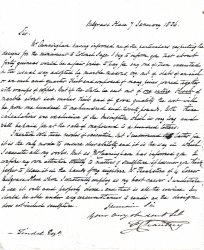
[Sir Francis Chantrey, sculptor, and his secretary Allan Cunningham, poet.] Manuscript Letter, written and signed by Cunningham on behalf of Chantrey, to William Tindal, regarding a monument to Colonel Page, with letter from Tindal to Mrs Page.
An excellent document, providing an invaluable view of the practicalities of commissioning and executing public monuments in the Georgian period. See Chantrey's entry in the Oxford DNB, and Cunningham's, which states: 'In 1814 he was engaged by Chantrey as superintendent of his establishment, and gave up writing for newspapers. He lived afterwards at 27 Lower Belgrave Place, Pimlico. He acted as Chantrey's secretary, conducted his correspondence, represented him during his absence, and occasionally offered artistic assistance. He became a favourite of Chantrey's sitters and visitors. This employment lasted until Chantrey's death in 1841 when Cunningham was left an annuity of £100.' Both letters are on the same 4to bifolium, with Cunningham’s letter (signing as Chantrey) to Tindal covering the recto of the first leaf, and Tindal’s letter to Mrs Page covering the recto of the second leaf and continuing to the reverse, which also carries the address to ‘Mrs. Page / Speen / Newbury’, and a red wax seal and postmark. ONE: Cunningham (signing as ‘F Chantrey’) to Tindal, 7 January 1836. Cunningham’s hand is distinctive, and there is no question that he has written the letter of nineteen lines, addressed to ‘- Tindal Esqr.’ The first paragraph reads: ‘Mr. Cunningham having informed me of the particulars respecting the designs for the monument to Colonel Page I beg to inform you that about forty guineas would be a fair price to pay for any one of them executed in the usual way adopted by marble masons, viz: out of slabs of an inch or an inch and quarter thick and composed of many pieces joined together with cramps of copper. But if the whole be cut out of one entire block of marble about six inches thick and of good quality the cost will be from one hundred to one hundred and twenty pounds. Both these calculations are exclusive of the Inscription which is very long and will be paid for at the rate of one pound to a hundred letters.’ The second paragraph is slightly shorter, with the suggestion that the matter be placed ‘in the hands of my neighbour Mr. Theakstone of 4 Lower Belgrave Place whom I constantly employ as my best carver’. TWO: ‘Wm. Tindal’ to ‘Mrs Page’. Thirty-eight lines. He begins by reporting that ‘Mr Crosby’ has seen Theakstone in Chantrey’s studio, ‘at work there on a statue of Bishop Heber - You may conclude therefore that he is an excellent workman’. He explains that if Theakstone is employed, Chantrey will continue to superintend the project, though Chantrey ‘means you to understand that he does not like putting his own name to anything but proper sculpture’. He proceeds to discuss the ‘practical point of execution’, from whether to use grey or black marble, to the construction of the base.


